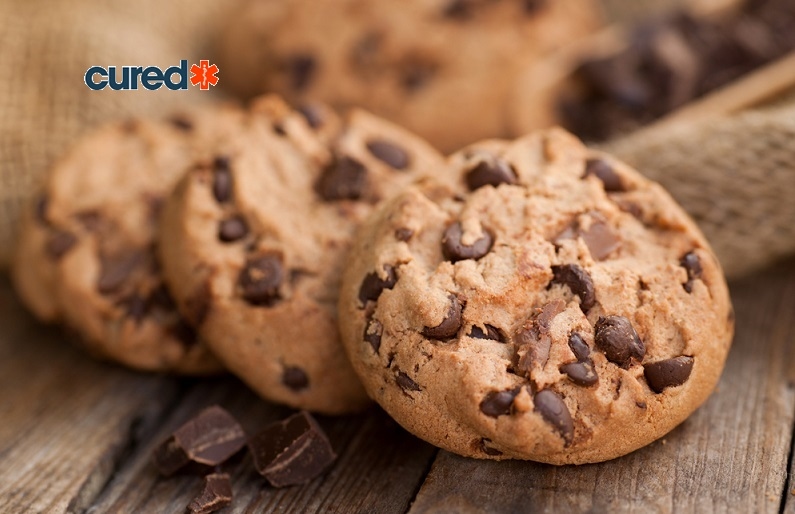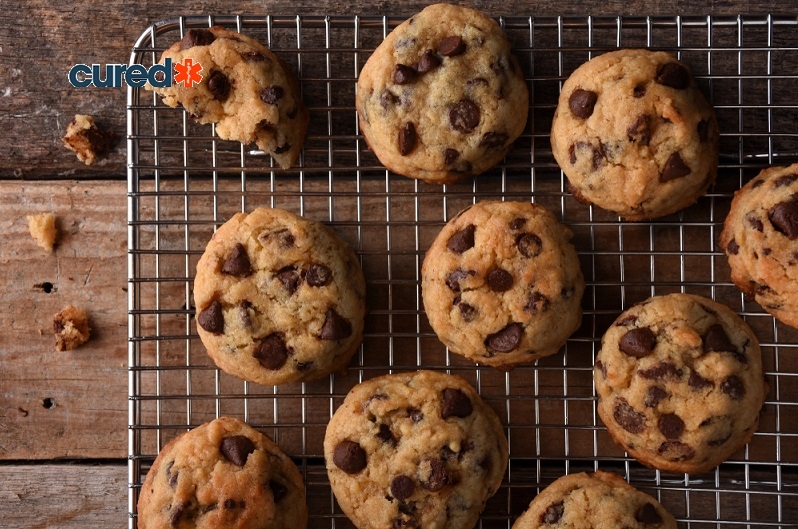Homemade Chocolate Chip Cookie: Importance Of Butter & Eggs

The basic ingredients and techniques for traditional chocolate chip cookies lie in the same formula. Butter, brown sugar, and creamed butter are combined just until butter appears, eggs are added one by one, the flour is added one by one, and the flour is thinned using cinnamon or sugar. For every step you take in baking a cookie, follow these steps, as described below:
The spread of the dough occurs as the butter warms, causing it to slack. During the baking process, the dough becomes softer as it bakes. In response to the spreading of the cookie, the edge of the cookie thins out. Moreover, since they have been exposed entirely to the oven heat for a while now, they keep reaching an increasingly hot place on the baking sheet, leading to them setting sooner than the middle to achieve a set.
A baked homemade chocolate chip cookie is set as soon as the protein and starch set reaches a temperature that is higher than what is required. As soon as the temperature is reached, egg proteins and starch proceed to set out, which determines the size and shape of the cookie after it is baked. In the hottest areas of the sugar, such as the edges and underbelly in which the granules are in contact with the surface of the bakeable mold, the sugar mellows, becoming liquid before maturing as it begins to darken and caramelize, enhancing the sweetness of the sugar.
The cooling process begins: As soon as the homemade chocolate chip cookie is out of the oven, cooling is still going on. Are you familiar with that liquefied sugar? During cooling, the sugar gets hard, resulting in a crunchy, gooey texture. In the meantime, the center of the cookie cools, resulting in a slight deflating; however, after baking, the egg and flour provide structure to the cookie, which prevents it from losing some of its height.
The texture and flavor of a cookie are affected by butter
Many recipes begin with butter, which provides several benefits.
It has been proven that more butter leads to more tender cookies
A cookie's tenderness is kept by butter. The combination of flour and water, including egg water, creates gluten, a thick, interconnected network of fibers so that they are set up after baking. The formation of gluten cannot occur in fat, which is why butter will prevent it from happening in general, resulting in more tenderness. When butter is proportioned in the recipe, the homemade chocolate chip cookie will become more tender, thus increasing the width of the cookie when it is baked. We recommend a flour-to-sugar-to-butter ratio of 1 to 0.8. We prefer a cookie size that is moderately spread and does not end up cakey in terms of its texture. As a result of the different melting properties of shortening despite containing no water, cookies made with shortening tend to be firmer and softer than butter-based cookies.

Butter that is melted is denser and chewier
A homemade chocolate chip cookie recipe's texture can also be affected by how butter is incorporated. When a cookie is whipped, cool butter is whipped until it is light, fluffy, and thick. There is some air incorporated into the butter during the process, as well as some sugar dissolved in the water phase of the butter. As a result, the cookies are left throughout the baking, lifting them slightly. When butter is melted before being mixed after you have added sugar and egg, it produces squatter, denser cookies.
There is no better flavor in cookies than butter
The flavor of food depends on butter. The substitution of butter for a less tasty fat, such as shortening or margarine, resulted in cookies that were below average. The butterfat content is 78 to 82%, the water content is 14%, and the milk protein content is 4 to 6%. A cookie's protein browns as it bakes, adding a bit of nuttiness and buttery taste.
The texture and shape of cookies are affected by eggs
Let's take a look at what eggs can do in cookies before moving on to the solution. Protein and water are plentiful in egg whites. Bubbles of air or water vapor are especially effective at entrapping and retaining them at egg protein levels. A cookie will rise more if it contains more egg white. As a result of the additional water, more gluten is also formed, increasing cookie thickness if the flour is sufficient for the additional water to be absorbed. With the exception of the small amount that is in the butter, cookies are mostly made with eggs.
Aside from providing some moisture and protein, eggs also provide some protein, and they also provide fat that is well emulsified. In the presence of cooked egg yolks, there is a coagulum of proteins to maintain a fudge-like texture in cookies. The texture of a homemade chocolate chip cookie is more brownie-like when there is a high proportion of egg yolk in it.

The thicker the cookies, the more egg whites there are
You can achieve a variety of textures by keeping the amount of egg addition on the same level, if you adjust the ratio between white and yolk, various textures can be achieved. Three yolks and no whites, for instance, give the cookie on top a more open structure, which results in the cookie on the bottom being denser and fudgier. The combination of egg whites with egg yolks that appeals to us is one-to-one, corresponding to the natural composition of eggs. That's pretty cool, isn't it?
Warmer butter makes them denser
It turned out that half the sugar and half of the eggs were beaten to a dissolved state, then the brown butter was added. It is also important to cool the butter beforehand which affects its air tightness after mixing with the eggs. Butter that is warm flows extremely easily and does not hold bubbles as well as cold butter. It becomes viscous as it cools, allowing air to be trapped better. There is a difference of even a few degrees. As soon as the browned butter was cooled to room temperature, you could beat it into the mixture of eggs, sugar, and cream without causing them to deflate.
Keeping a balance of sugars is important
The sweetness of sugar is not the only thing sugar has in common. It is important to consider the type and method of sugar you used during the baking process in order to make sure that your cookies are as tasty as possible.

Granular sugar is thin and crisp in comparison
Sugar that has been granulated is sucrose, a disaccharide composed of fructose and glucose. There is a mild degree of hygroscopicity, which means it is very good for retaining moisture, as well as a relatively neutral pH value. A clear difference can be seen in the spread. Taking into consideration that baking soda in the recipe is a powdered form of baking soda, then requiring some amount of acid to create the bubbles that are necessary in order for the cookie to become leavened. It is due to the slightly acidic flavor of brown sugar that cookies are able to raise more than most other cookies when baked, limiting their ability to spread. The difference between granulated sugar and whole sugar is that it does not add any leavening power, making cookies spread. The reason why cookies made with granulated sugar tend to lose moisture is because they are also crisper when they are baked.
A combination of the two creates a good balance, but, in egg testing, a high concentration of sugar results in uniform textures. In the case of melted sugar remaining in distinct grains, melted sugar pockets on the cookie that caramelize don't look very uniform, which adds a substantial amount of texture to the cookie.
Conclusion
When you understand how ingredients interact, the benefit you gain is that if your definitions of homemade chocolate chip cookies are different, and if so far you have come along so far, you have a way to modify your recipe accordingly. Are you a fan of chewy cookies? The all-purpose flour could be substituted with bread flour in some recipes. Are you looking for a way to make your cookies rise higher? Make the dough sweeter by adding a little baking powder or substituting an extra white for the yolk. Would you prefer to have distinct pockets in your chocolate? Hand-chopped chocolate is not as effective as chocolate chips. Need more flexibility and chewiness in your cookies? Corn syrup can be substituted for sugar.
Tour Price
Our private tours typically range from $500 - $1000 per person/per night depending on chosen hotels and room categories, vehicles used, types of tours, flight cost, time of year and other factors. Make an inquiry for a customized trip quote.

